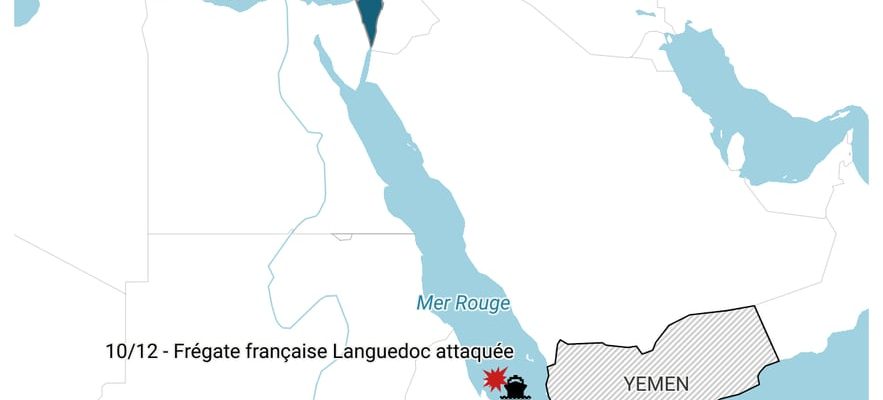In the dark night, the French multi-mission frigate (FREMM) Languedoc fired on Saturday, December 9, in the Red Sea, for what was not an exercise. This shot down two drones coming in its direction from the Yemeni coast, near the port of Al-Hodeida, held by the Houthi rebels. On December 11, it destroyed a new drone which, this time, threatened a Norwegian oil-chemical tanker, the Strinda. The boat was nevertheless hit by a cruise missile which caused damage, but no injuries. The Strinda was then escorted by Languedoc, “preventing the attempt to hijack the ship”, according to the Ministry of the Armed Forces.
These military interventions are a reminder that France is on the front line of the current “battle” of the Red Sea, where it has long been accustomed. “It has been present there since the second half of the 19th century, when it settled in the current territory of Djibouti, where it still maintains a base,” recalls researcher Marc Lavergne, who co-edited an issue of the journal Strategic Orients dedicated to the Red Sea. Already, in 1972, a French vessel, the destroyer Dupetit-Thouars, had been targeted and hit by Yemeni shells.
Now, the French army is faced with military excesses orchestrated by the Houthis, a militia controlling the northern part of Yemen, from the Zaidi Shiite minority, and close to Iran. In reaction to the intervention of the Israeli army in Gaza, against Hamas, they declared war on Israel, which they target with drone and missile fire. They do the same with boats using the Red Sea, one of the densest shipping routes in the world, connecting Europe and Asia, via the Suez Canal, but also one of the narrowest.
With a width of 27 kilometers, the Bab-el-Mandeb Strait, between Djibouti and Yemen, sees 40% of international trade transit. “It is a passage of extreme importance for France and the Europeans, underlines a military source who knows the region well. And one of the most monitored in the world since the European operation Atalante to fight against piracy in the Horn of Africa, which remains an indispensable point of support.”
The Houthis increase their operations in the Red Sea
© / The Express
Increasing attacks
There is enough to maintain the crew of the Languedoc on maximum vigilance: other attacks have involved the Houthi rebels in recent weeks. Thanks to a commando dropped by helicopter, they took control of the merchant ship Galaxy Leader, owned by an Israeli businessman, on November 18. They also attacked other ships, claiming that they were, again, Israeli-owned, or that they were bound for Israeli ports. On several occasions, an American destroyer, the USS Carney, has shot down missiles and drones, some of which were heading in its direction, as was the case on December 9 for the Languedoc.
We have to go back to 1987 to find the last “surface-air” feat of the French army: with a missile fired from a Hawk battery, in Chad, it destroyed a Libyan plane targeting N’Djamena. There Languedoc used Aster 15 anti-aircraft missiles for the three interceptions carried out in recent days. “This sends the message that we do not hesitate to fire in the face of the threat, that we have particularly effective vessels, with highly trained crews, because the fight against drones is difficult, underlines the military source. But this also shows our allies that we can entrust responsibilities to the French.” On December 11, the USS Mason took over the escort of the Norwegian tanker Strinda, allowing the Languedoc to resume its patrol further north of the strait.
However, these interceptions highlight the limits of FREMM weapons. An Aster 15 missile costs more than a million euros, compared to tens of thousands of euros for a Houthi drone. And such a frigate can only carry 16, at most. “When we kill a Shahed [drone iranien] with an Aster, in reality it was the Shahed which killed the Aster” by reducing our anti-aircraft defenses, the Chief of Staff of the French Armies, General Thierry Burkhard, recently argued during a conference “If we want to win the war, we will have to develop inexpensive weapons of attrition, alongside high-tech weapons that make it possible to win the decision.”
.
